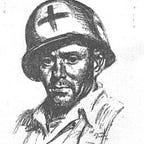Medical Planners, DSCA Operations, and Natural Disasters
Written by MAJ Casey Wilson
Medical Planners play a critical role in the support of the welfare and safety of our citizens during natural disasters. This hurricane season was unlike anything seen in the US before, in that four Level 4 hurricanes wreaked havoc on the US within two months. Hurricanes and Tropical Storms comprise one of the most significant risks for the Federal Emergency Management Agency (FEMA). Hazards from these systems include wind damage, storm surge flooding, displaced people, and the potential for significant inland flooding. Tropical systems often affect a very large geographical area complicating mission command of tasked organized units, stretching agency resources, and creating additional challenges and issues. Most recently, with Hurricane Maria, Puerto Rico experienced an extensive loss of power that had cascading impacts effecting other systems such as water treatment and distribution, sewage treatment, and basic services that create a need for extensive medical and logistical support. The focus of Department of Defense (DoD) medical support during Defense Support of Civil Authorities (DSCA) operations is to restore essential health services in collaboration with the state and local health authorities.
The focus of DoD medical support during a DSCA operation is to restore essential health services in collaboration with the state and local health authorities.
A primary missions of the Forces Command (FORSCOM) Surgeon’s directorate is to provide professional medical expertise and tactical or operational assistance to deploy trained and ready forces to the Combatant Commander in support of (ISO) contingency operations. One way the directorate provides this assistance is by being an active member of the FORSCOM Crisis Action Team (CAT). During events when severe weather is projected to cause major damage, loss of life, or short-notice sourcing and deployment of forces, the CAT monitors the situation, maintains contact with Headquarters Department of the Army (HQDA), US Northern Command (USNORTHCOM), US Army North (USARNORTH), and monitors FEMA traffic (or other supported commands). FORSCOM provides forces within the National Response Framework to USNORTHCOM and Federal Agencies for domestic incidents including disasters (natural and/or man-made), Chemical, Biological, Radiological, or Nuclear (CBRN) incidents, civilian law enforcement assistance, and other designated support. Medical Planners identify medical forces necessary and available to deploy ISO ongoing operations.
Incident response is managed at the lowest level possible and military assets always function in a supporting role during DSCA operations. Federal support is provided in response to requests from state or local officials through the state coordinating officer to the federal coordinating officer. From the start of the incident, to the arrival of the unit, the medical planner must take a number of steps to secure authorization, funding, and movement of resources. For example, a need for medical supplies was identified by a local field office in Puerto Rico and a request for support was sent to generate the requirement. Medical Planners in the CAT identified the capability needed and assigned resources against this requirement.
Incident response is managed at the lowest level possible and military assets always function in a supporting role during DSCA operations.
The 6th Medical Logistics Management Center (MLMC) responded to the DSCA operation for both Hurricane Harvey and Hurricane Maria. The unit was placed under Operational Control (OPCON) of USARNORTH on August 27, 2017 and provided staff augmentation for the Single Integrated Medical Logistics Manager mission at Joint Base San Antonio (JBSA) until September 14, 2017, which helped coordinate and integrate the joint medical logistics common operating picture in Texas. Later that month, the unit sent a MLMC Support Team to Puerto Rico to provide staff augmentation to USARNORTH at JBSA in response to Hurricane Maria. The Puerto Rico team established the Medical Logistics Support Plan and assisted incoming units establish CL VIII accounts with the Continental United States (CONUS) Master Ordering Facility.
As a medical planner, it is imperative the medical capability is clearly identified and defined so the correct medical assets are resourced. During DSCA operations, the medical planner provides the battle staff with medical information and current running estimates relevant to the crisis, situation, or mobilization. Medical planners continue to monitor and provide updates on medical support operations, readiness of medical equipment, and the Professional Filler System (PROFIS) personnel for all units with the potential to be activated. The focus of DoD medical support is to restore essential health services in collaboration with the state and local health authorities. The medical planner establishes the plan for recovery in collaboration with state and local health authorities.
MAJ Casey Wilson, a native of Canton, Michigan, enlisted in the military in 1995 and accepted a Green-to-Gold scholarship in 1998. She commissioned from the Univ. of Michigan in 2002. She has masters degrees in Industrial/ Organization Psychology and Public Health. She has served as a Platoon Leader, FST XO, BN staff, BDE Staff, DIV Staff, LTHET student and attended CGSC. She is currently the Medical Operations Planner-Readiness in FORSCOM. She is married to LTC JP Wilson and is the mother of three wonderful young ladies. The views expressed in this article are the author’s alone and do not reflect the official position of the Medical Service Corps, the Department of Defense, or the US Government.
